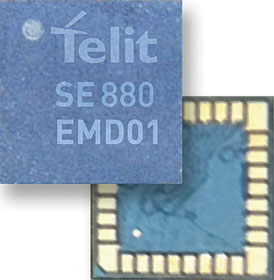

Telit Wireless Solutions recently rolled out the Jupiter SE880 GPS receiver module for applications in the commercial, industrial and consumer segments including wearable and handheld devices.
The 4,7 x 4,7 mm LGA (land grid array), SiRFstarIV-based device employs advanced 3D component embedding technology and was conceived to shorten time to market by reportedly allowing integrators to attain a working SE880-based design in as little as a week versus several months when starting from a chipset reference design.
The module includes all components necessary for a fully functioning receiver design, requiring only a 32 kHz external crystal for its time base and TCXO to complete the design, along with antenna, power and data connections adequate to the integrator’s needs.
For advanced designs incorporating the supported Satellite Based Augmentation System (SBAS), ephemeris data collected from the satellites can be stored to SPI Flash memory instead of the more common and expensive EEPROM alternative.
Responsible for delivering very high sensitivity, the Jupiter SE880’s RF front-end employs spatially calibrated waveguide-quality radio paths inside the three-dimensional space of its architecture to mitigate the parasitic impedances characteristic of traditional 2D RF designs.
Inside, a multi-filter system includes not only the traditional SAW filters typical in GPS receiver designs but also a 2,4 GHz notch filter capable of nullifying the jamming effects of high-energy radio devices such as Wi-Fi hotspots, Bluetooth systems, cordless phones and others, which greatly affect a GPS receiver’s ability to resolve timid satellite signals in the hostile radio environment where they need to operate.
Jupiter SE880 is a single-constellation GPS product enhanced for maximum sensitivity which makes it capable of achievements such as a one-satellite acquisition of UTC (typically four are required); fix acquisition with minimal sky visibility - indoors, garages, urban canyons, etc; and much lower TTFF under standard operating conditions (as much as 200 seconds quicker from cold start).
In its micro-power standby mode, the module draws 50 to 500 μA making it extremely battery friendly. It can produce a first fix in a few seconds when waking from a few hours of standby and less than 10 seconds when waking from a full day of standby, making it ideal for wearable and personal digital device applications.
Other distinguishing features of the SE880 include an extended operating temperature range wherein noise-versus-gain performance is linearly balanced throughout the range with high sensitivity stability particularly at the extremes of -40°C and +85°C – critical for applications such as sports watches and OEM automotive navigation systems.
Six-Sigma quality assurance processes employed in producing the Jupiter SE880 significantly increase manufacturing yields for the integrator’s end-product. That is due to a number of factors including the product’s higher tolerance to satellite signal variances input to its RF front end (less than 1 dB part to part variation versus a more typical tolerance range of 3 dB); and other maladies introduced by the end-manufacturing process.

© Technews Publishing (Pty) Ltd | All Rights Reserved